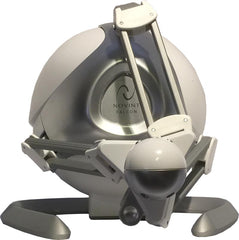Research and Development - Given the fidelity and robustness of the Falcon, and given its cost, it is truly suited to powerful use in haptic research and development. The Falcon has been used for study in a variety of reseach contexts ranging from haptic algoritms to human perception to human haptic capability. It can be used in research within all of the fields described below, for example. The Falcon is an excellent device for students and professors studying haptics or working in any type of 3D environment. We offer educational discounts to researchers.
Medical Simulation - The Falcon has successfully been used in a variety of medical simulations. Perhaps the most amazing thing about the Falcon is its incredible fidelity and realism for its price point. It has the capabilities of robots that cost over ten thousand dollars. It can be used to simulate a needle pushing through different anatomical structures, a scalpel cutting into tissue, the handle of an arthroscopic instrument, or nearly any other hand held surgical instrument. The Falcon has been used with different types of physical handles representing what a surgeon would actually hold on to during a surgical procedure, such as a 2 DOF tracked syringe handle that attaches to the Falcon. In this way a surgeon can literally hold what they would hold during the medical procedure, and feel what is felt during the medical procedure. Currently, doctors learn through age old apprenticeship - see one, do one, teach one. Doctors actually learn many of their skills on live patients. Medical simulation is an important use of haptics, as it solves difficult problems in the medical field. It can replace cadavers, animals, and cumbersome physical simulators. Some day, using haptics, all doctors will become experts at procedures before they touch a patient.
Video Games - The Falcon was originally mass produced as a 3D gaming controller. It can simulate a gun recoil, the feel of a golf swing, a car impact, or the throw of a football. For the first time people can be the character and feel what the character feels rather than simply push buttons to control the character.
Scientific Visualization - In scientific visualization, a powerful 3D input device can be an immensely useful tool. Even without using the Falcon's force feedback capabilities, it is a powerful 3D mouse. The Falcon can be used to fly through a virtual dataset or simulation, cut through the data with a clipping plane, or take data measurements directly within the data. It can be used to place objects. Forces can be added to further insight into scientific data. For example vibrations or force vectors can be used to understand a multi-variate data set more intuitively. Humans are very good at parsing through and understanding patterns in data, and the Falcon is a tool to give that insight to people.
Virtual Reality - The Falcon is a powerful 3D controller. It can be used to touch and interact with objects in 3D environments. If you pick up a book or a glass, you can feel its weight. You can feel when you set it back on a table. You can feel yourself bump into a door, lift a window open, or turn on a faucet handle and then feel the flow of the water as it runs past your hand. When coupled with a head mounted display, the Falcon can control your hand and let you feel what your avatar feels making it seem as if you are actually there in the virtual environment. It can take the 'virtual' out of virtual reality.
3D Modeling and Animation - The Falcon can be used as a 3D input to manipulate objects and characters easily and intuitively. A character's hand can be grabbed and moved, and with inverse kinematics, the character can be quickly positioned. The Falcon can control sculpting and other modeling tools to give an artistry than cannot be accomplished by a 2D device (such as a mouse) and which also cannot be accomplished without force feedback.
Telerobotics - The Falcon can be used to robotically control other robots. It can control a surgical robot arm, giving a surgeon a realistic sense of touch when performing a surgical procedure. It can control robots in situations that are unsafe for humans, such as a bomb diffusing robot or a drone.
* - Novint and Novint Falcon are trademarks of Novint Technologies Inc. All product and company names are trademarks™ or registered® trademarks of their respective holders. Use of them does not imply any affiliation with or endorsement by them.

